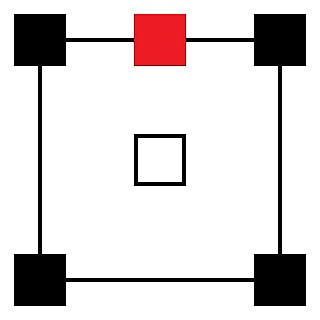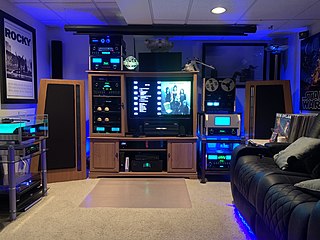Dolby Digital, originally synonymous with Dolby AC-3, is the name for a family of audio compression technologies developed by Dolby Laboratories. Called Dolby Stereo Digital until 1995, it is lossy compression. The first use of Dolby Digital was to provide digital sound in cinemas from 35 mm film prints. It has since also been used for TV broadcast, radio broadcast via satellite, digital video streaming, DVDs, Blu-ray discs and game consoles.

Home cinema, also called home theaters or theater rooms, are home entertainment audio-visual systems that seek to reproduce a movie theater experience and mood using consumer electronics-grade video and audio equipment that is set up in a room or backyard of a private home. Some studies show films are rated better and generate more intense emotions when watched in a movie theater, however, convenience is a major appeal for home cinemas. In the 1980s, home cinemas typically consisted of a movie pre-recorded on a LaserDisc or VHS tape; a LaserDisc Player or VCR; and a heavy, bulky large-screen cathode ray tube TV set, although sometimes CRT projectors were used instead. In the 2000s, technological innovations in sound systems, video player equipment and TV screens and video projectors have changed the equipment used in home cinema set-ups and enabled home users to experience a higher-resolution screen image, improved sound quality and components that offer users more options. The development of Internet-based subscription services means that 2016-era home theatre users do not have to commute to a video rental store as was common in the 1980s and 1990s.

Quadraphonic sound – equivalent to what is now called 4.0 surround sound – uses four audio channels in which speakers are positioned at the four corners of a listening space. The system allows for the reproduction of sound signals that are independent of one another.

Surround sound is a technique for enriching the fidelity and depth of sound reproduction by using multiple audio channels from speakers that surround the listener. Its first application was in movie theaters. Prior to surround sound, theater sound systems commonly had three screen channels of sound that played from three loudspeakers located in front of the audience. Surround sound adds one or more channels from loudspeakers to the side or behind the listener that are able to create the sensation of sound coming from any horizontal direction around the listener.

dbx is a family of noise reduction systems developed by the company of the same name. The most common implementations are dbx Type I and dbx Type II for analog tape recording and, less commonly, vinyl LPs. A separate implementation, known as dbx-TV, is part of the MTS system used to provide stereo sound to North American and certain other TV systems. The company, dbx, Inc., was also involved with Dynamic Noise Reduction (DNR) systems.
Dolby Pro Logic is a surround sound processing technology developed by Dolby Laboratories, designed to decode soundtracks encoded with Dolby Surround. The terms Dolby Stereo and LtRt are also used to describe soundtracks that are encoded using this technique.

Dolby Laboratories, Inc. is a company specializing in audio noise reduction, audio encoding/compression, spatial audio, and HDR imaging. Dolby licenses its technologies to consumer electronics manufacturers.
Matrix decoding is an audio technology where a small number of discrete audio channels are decoded into a larger number of channels on play back. The channels are generally, but not always, arranged for transmission or recording by an encoder, and decoded for playback by a decoder. The function is to allow multichannel audio, such as quadraphonic sound or surround sound to be encoded in a stereo signal, and thus played back as stereo on stereo equipment, and as surround on surround equipment – this is "compatible" multichannel audio.

DTS, Inc. is an American company, DTS company makes multichannel audio technologies for film and video. Based in Calabasas, California, the company introduced its DTS technology in 1993 as a competitor to Dolby Laboratories, incorporating DTS in the film Jurassic Park (1993). The DTS product is used in surround sound formats for both commercial/theatrical and consumer-grade applications. It was known as The Digital Experience until 1995. DTS licenses its technologies to consumer electronics manufacturers.
Dolby Stereo is a sound format made by Dolby Laboratories. It is a unified brand for two completely different basic systems: the Dolby SVA 1976 system used with optical sound tracks on 35mm film, and Dolby Stereo 70mm noise reduction on 6-channel magnetic soundtracks on 70mm prints.

An audio/video receiver (AVR) is a consumer electronics component used in a home theater. Its purpose is to receive audio and video signals from a number of sources, and to process them and provide power amplifiers to drive loudspeakers and route the video to displays such as a television, monitor or video projector. Inputs may come from a satellite receiver, radio, DVD players, Blu-ray Disc players, VCRs or video game consoles, among others. The AVR source selection and settings such as volume, are typically set by a remote controller.

DTS-HD Master Audio is a multi-channel, lossless audio codec developed by DTS as an extension of the lossy DTS Coherent Acoustics codec. Rather than being an entirely new coding mechanism, DTS-HD MA encodes an audio master in lossy DTS first, then stores a concurrent stream of supplementary data representing whatever the DTS encoder discarded. This gives DTS-HD MA a lossy "core" able to be played back by devices that cannot decode the more complex lossless audio. DTS-HD MA's primary application is audio storage and playback for Blu-ray Disc media; it competes in this respect with Dolby TrueHD, another lossless surround format.

SQ Quadraphonic was a matrix 4-channel quadraphonic sound system for vinyl LP records. It was introduced by CBS Records in 1971. Many recordings using this technology were released on LP during the 1970s.

Center channel refers to an audio channel common to many surround sound formats. It is the channel that is mostly, or fully, dedicated to the reproduction of the dialogue of an audiovisual program. The speaker(s) connected to the center channel are placed in the center of and behind the perforated projection screen, to give the effect that sounds from the center channel are coming from the screen. In many home surround sound units, the center channel is positioned above or below the video screen.

Home audio systems refer to audio consumer electronics designed for home entertainment, such as integrated systems like shelf stereos and music centers, as well as individual components like loudspeakers and surround sound receivers. The evolution of home audio began with Edison's phonograph, transitioning from monaural to stereophonic sound in the 1950s and 60s. The term "hi-fi" emerged, highlighting sound accuracy and minimal distortion. Audio equipment evolved from large wooden cabinets to compact units. The 1970s introduced enhancements like quadraphonic sound and technologies like Dolby Pro Logic. The 1970s and 1980s also saw the rise of component-based stereo systems. Cassette decks became a staple in the 1970s. Integrated systems, termed "music centers" gained popularity in the 1980s. Table systems and compact radio receivers emerged as entertainment devices, with some offering features like cassette players and CD functionalities. Audiophile systems prioritize high-quality music formats and specialized equipment like premium turntables, digital-to-analog converters, and other high-end devices, with some enthusiasts preferring the unique sound characteristics of vinyl records and vacuum tubes. Modern systems often emphasize home cinema applications to enhance the audio experience beyond standard TV speakers.
Dolby Atmos is a surround-sound technology developed by Dolby Laboratories. It expands on existing surround sound systems by adding height channels, allowing sounds to be interpreted as three-dimensional objects with neither horizontal nor vertical limitations. Following the release of Atmos for the cinema market, a variety of consumer technologies have been released under the Atmos brand, using in-ceiling and up-firing speakers.
Peter Scheiber was a classically trained musician and audio engineer. He was considered to be the originator of multichannel matrix audio formats, a mathematical formula used to convert four audio channels into two and back again.

Quadraphonic Sound was a phase amplitude matrix 4-channel quadraphonic sound system for phonograph records. The system was based on technology created by Peter Scheiber, but further developed by engineer Ryosuke Ito of Sansui in the early 1970s.
The Hafler circuit is a passive electronics circuit with the aim of getting derived surround sound or ambiophony from regular stereo recordings without using costly electronics. Such circuits are generally known as matrix decoders. The Dynaquad system works using similar principles.
Stereo-4, also known as EV or EV-4, was a matrix 4-channel quadraphonic sound system developed in 1970 by Leonard Feldman and Jon Fixler.












